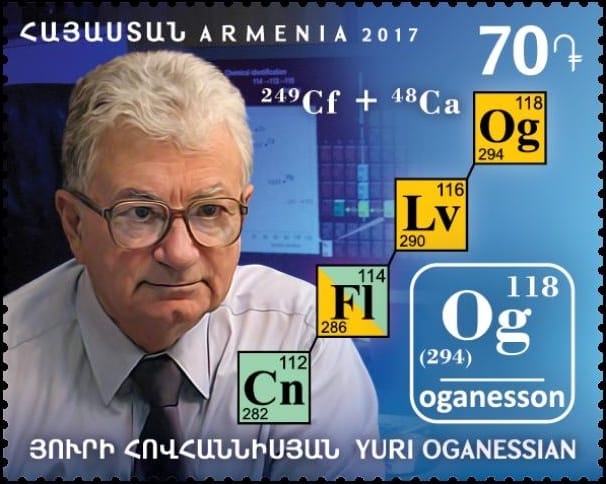oganesson

Oganesson is a synthetic chemical element with atomic number 118 and the symbol Og. The element is named for Yuri Oganessian (b. 1933), a lead researcher at the Joint Institute for Nuclear Research in Dubna, Russia. Oganesson is the second element to be named after a living person, the other being seaborgium, named for chemist Glenn Seaborg, the discoverer of plutonium. Oganesson was first synthesized in 2002 in a collaborative effort between the Joint Institute and the Lawrence Livermore National Laboratory in California.
On the periodic table, oganesson is grouped with the other noble gases, and it was given the -on suffix because of this. But the element’s chemical properties are largely unknown, and it may be that the element is more reactive than the other inert noble gases.
The first public mention of the name oganesson is a speculative one. In April 2016, the journal Nature Chemistry published a commentary by four scientists guessing at what would be the names of elements 113, 115, 117, and 118, which had been synthesized but not yet officially named:
Will a modern scientist be honoured, as in Philip’s selections of ghiorsonine or oganesson? Or one of the greats, such as Eric and Brett’s suggestion of moseleyon for 118? Or might they, perhaps, pick something that no one else has thought of so far? We’ll just have to wait and see.
Two months later, on 8 June 2016, the International Union of Pure and Applied Chemistry (IUPAC) announced the official name:
For the element with atomic number 118 the collaborating teams of discoverers at the Joint Institute for Nuclear Research, Dubna (Russia) and Lawrence Livermore National Laboratory (USA) proposed the name oganesson and symbol Og. The proposal is in line with the tradition of honoring a scientist and recognizes Professor Yuri Oganessian (born 1933) for his pioneering contributions to transactinoid elements research. His many achievements include the discovery of superheavy elements and significant advances in the nuclear physics of superheavy nuclei including experimental evidence for the “island of stability."
New IUPAC guidelines formulated in 2016 require new elements be named after either a mythological character or concept (or an astronomical object named after such a mythological concept), a mineral, a place, or a scientist. Elements in columns 1–16 of the periodic table take the usual suffix -ium. Those in column 17 take the suffix -ine, and those in column 18 the suffix -on. Of course, older names for elements may not conform to these guidelines.
Sources:
Burdette, Shawn C., Philip Ball, Kat Day, Eric R. Scerri and Brett F. Thornton. “Another Four Bricks in the Wall.” Nature Chemistry, 8.4, April 2016, 283–88 at 288. DOI:10.1038/nchem.2482
International Union of Pure and Applied Chemistry (IUPAC). “IUPAC Is Naming the Four New Elements Nihonium, Moscovium, Tennessine, and Oganesson
(press release), 8 June 2016.
Miśkowiec, Pawel. “Name Game: The Naming History of the Chemical Elements—Part 3—Rivalry of Scientists in the Twentieth Century.” Foundations of Chemistry, 12 November 2022. DOI: 10.1007/s10698-022-09452-9.
Image credit: Armenia Post, 2017. Wikimedia Commons. Public domain image.